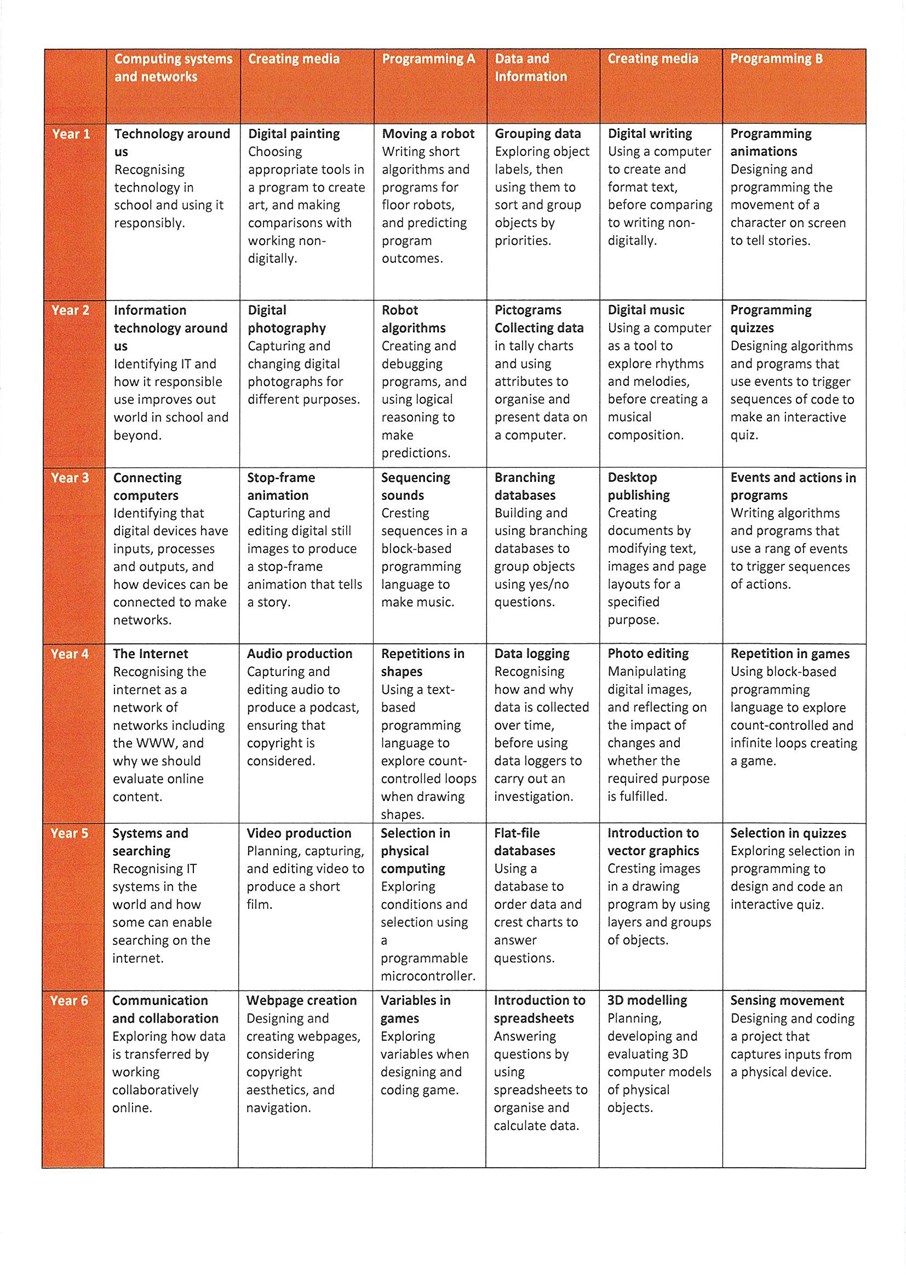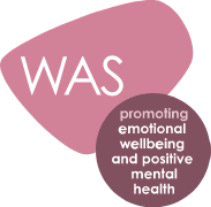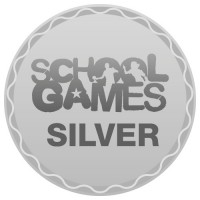Computing education is vital, because it has social, cultural and economic benefits for our children now and in their futures. Through computing education, our children can learn ‘powerful knowledge’, enabling them to become informed and active participants in our increasingly digital society.
Computing education is important for pupils to make sense of and to contribute positively to our technologically diverse world.
Our aim is to deliver a high-quality computing curriculum that teaches our pupils to use computational thinking and creativity to understand and change their world.
The national curriculum for computing aims to ensure that all pupils:
- can understand and apply the fundamental principles and concepts of computer science, including abstraction, logic, algorithms and data representation
- can analyse problems in computational terms, and have repeated practical experience of writing computer programs in order to solve such problems
- can evaluate and apply information technology, including new or unfamiliar technologies, analytically to solve problems
- are responsible, competent, confident and creative users of information and communication technology.
Our curriculum is based around the three pillars of:
- computer science
- information technology
- digital literacy
Our aim is for our children to make progress in computing by knowing and remembering more about and, importantly, across each of these pillars being able to apply this knowledge.
Delivering the Computing Curriculum through Teach Computing ensures declarative knowledge (‘knowing that’) and procedural knowledge (‘knowing how’) are identified, sequenced and connected.
Computing is rich in abstract concepts that can be difficult for novices to learn. We have chosen the Teach Computing approach because it reduces cognitive overload and encourages children to develop expert knowledge over time. The use of the ‘unplug*, unpack and repack’ approach means abstract concepts can be taught using simpler, concrete examples, leading to children being able to know, remember and do more.
* an approach of exposing children to the ideas of computer science without using computers
The computing curriculum we have chosen uses predominantly explicit, scaffolded instructions as ‘unguided’ or ‘self-guided’ approaches are known to prevent or slow learning down, especially when a concept or skill is new to a child. However, some small group and independent problems are used as a means of practising recently learned content and skills’ Where possible we also use stories to share and communicate knowledge.
Online Safety
At Crestwood park, we use the Education for a Connected World Framework to ensure we are equipping our children with the knowledge needed to make the best use of the internet and technology in a safe, considered and respectful way, so they can reap the benefits of the online world.
Not all aspects of this framework are included in the Teach Computing Curriculum but our Online Safety Curriculum sets out the way we cover all aspects of the DfE Teaching Online Safety in Schools Guidance in other curriculum areas, assemblies and enrichment opportunities.
The Teach Computing Curriculum
We use the Teach Computing Curriculum to deliver the National Curriculum Computing Curriculum to children in KS1 and KS2.
The Teach Computing Curriculum reduces and removes some potential barriers to delivering a high-quality computing curriculum. Not all our teachers have in-depth subject expertise in computing so we have chosen resources that enhance the practice of experienced and confident teachers of computing, and support less confident and newly qualified teachers. It provides subject knowledge that is accessible to all teachers, meaning the delivery to our children can remain at a consistent high level.
Other benefits of teaching computing at Crestwood Park in this way are:
- the resources support all our children, irrespective of their skills, background, and additional needs
- the content is editable ensuring that the resources can be tailored to our teachers, our children and our school
- resources are regularly updated
- teaching resources are free, meaning we can spent our Computing Curriculum budget on the equipment needed to deliver the subject, to a high standard
- it links Crestwood Park to our local computing hub and a National Centre for Computing Education Champion, meaning we can access an expert in the teaching of computing, CPD for our staff and additional equipment if needed
Curriculum Design
The Teach Computing Curriculum uses the National Centre for Computing Education’s computing taxonomy to ensure comprehensive coverage of the subject. This has been developed through a thorough review of the KS1–4 computing programme of study, and the GCSE and A level computer science specifications across all awarding bodies. All learning outcomes can be described through a high-level taxonomy of ten strands*:
- Algorithms - Be able to comprehend, design, create, and evaluate algorithms
- Computer networks - Understand how networks can be used to retrieve and share information, and how they come with associated risks
- Computer systems - Understand what a computer is, and how its constituent parts function together as a whole
- Creating media - Select and create a range of media including text, images, sounds, and video
- Data and information - Understand how data is stored, organised, and used to represent real-world artefacts and scenarios
- Design and development - Understand the activities involved in planning, creating, and evaluating computing artefacts
- Effective use of tools - Use software tools to support computing work
- Impact of technology - Understand how individuals, systems, and society as a whole interact with computer systems
- Programming - Create software to allow computers to solve problems
- Safety and security - Understand risks when using technology, and how to protect individuals and systems
*Whilst all strands are present at all phases, they are not always taught explicitly.
Ambitious and Inclusive and designed to Build on Prior Learning
The Teach Computing Curriculum has been written to support all pupils. Each lesson is sequenced so that it builds on the learning from the previous lesson. The units for key stages 1 and 2 are based on a spiral curriculum. This means that each of the themes is revisited regularly (at least once in each year group), and pupils revisit each theme through a new unit that consolidates and builds on prior learning within that theme.
This style of curriculum design reduces the amount of knowledge lost through forgetting, as topics are revisited yearly. It also ensures that connections are made even if different teachers are teaching the units within a theme in consecutive years.
Where appropriate, activities are scaffolded so that all pupils can succeed and thrive. Scaffolded activities provide pupils with extra resources, such as visual prompts, to reach the same learning goals as the rest of the class.
Exploratory tasks foster a deeper understanding of a concept, encouraging pupils to apply their learning in different contexts and make connections with other learning experiences.
As well as scaffolded activities, embedded within the lessons are a range of pedagogical strategies:
- lead with concepts
- unplug, unpack, repack
- create projects
- challenge misconceptions
- structure lessons
- work together
- model everything
- add variety
- make concrete
- read and explore code first
- get hands-on
- foster program comprehension
You can find out more about the Teach Computing Pedagogy principles here.
Physical Computing
The Teach Computing Curriculum acknowledges that physical computing plays an important role in modern pedagogical approaches in computing, both as a tool to engage pupils and as a strategy to develop pupils’ understanding in more creative ways. Additionally, physical computing supports and engages a diverse range of pupils in tangible and challenging tasks.
The physical computing units in the Teach Computing Curriculum are:
Year 5 – Selection in physical computing, which uses a Crumble controller
Year 6 – Sensing movement, which uses a micro:bit
Assessment
Each computing lesson we teach includes an element of assessment, enabling teachers to modify and adapt the next lesson and to ensure that any misconceptions are recognised and addressed. Assessment strategies include multiple-choice questions, self-assessments and observations.
Curriculum Overview
Below is a link to our adopted curriculum map for Computing.
The tables below demonstrate how we use the Teach Computing Curriculum to deliver the KS1 and KS2 National Curriculum programmes of study for Computing in more detail.






